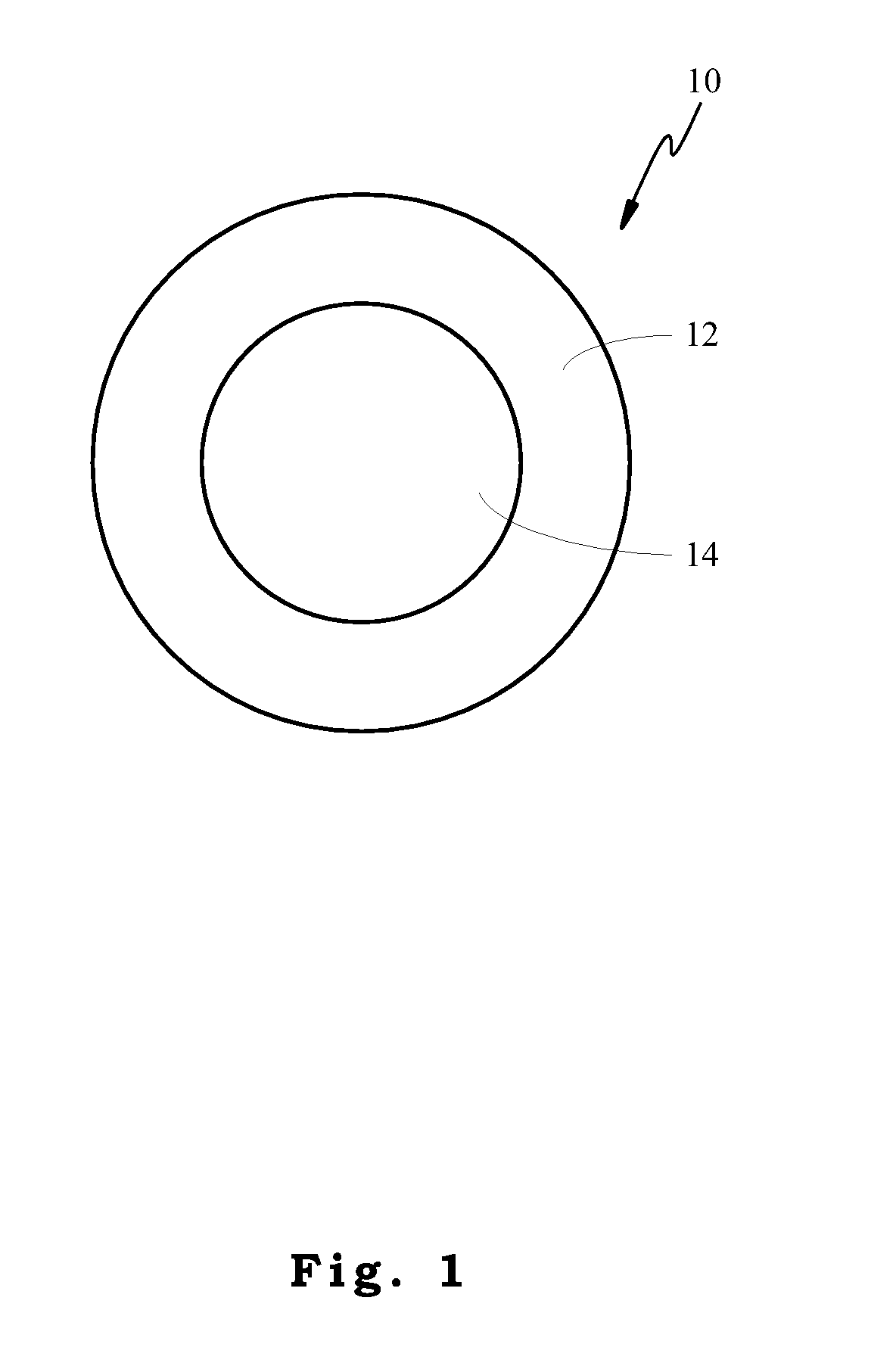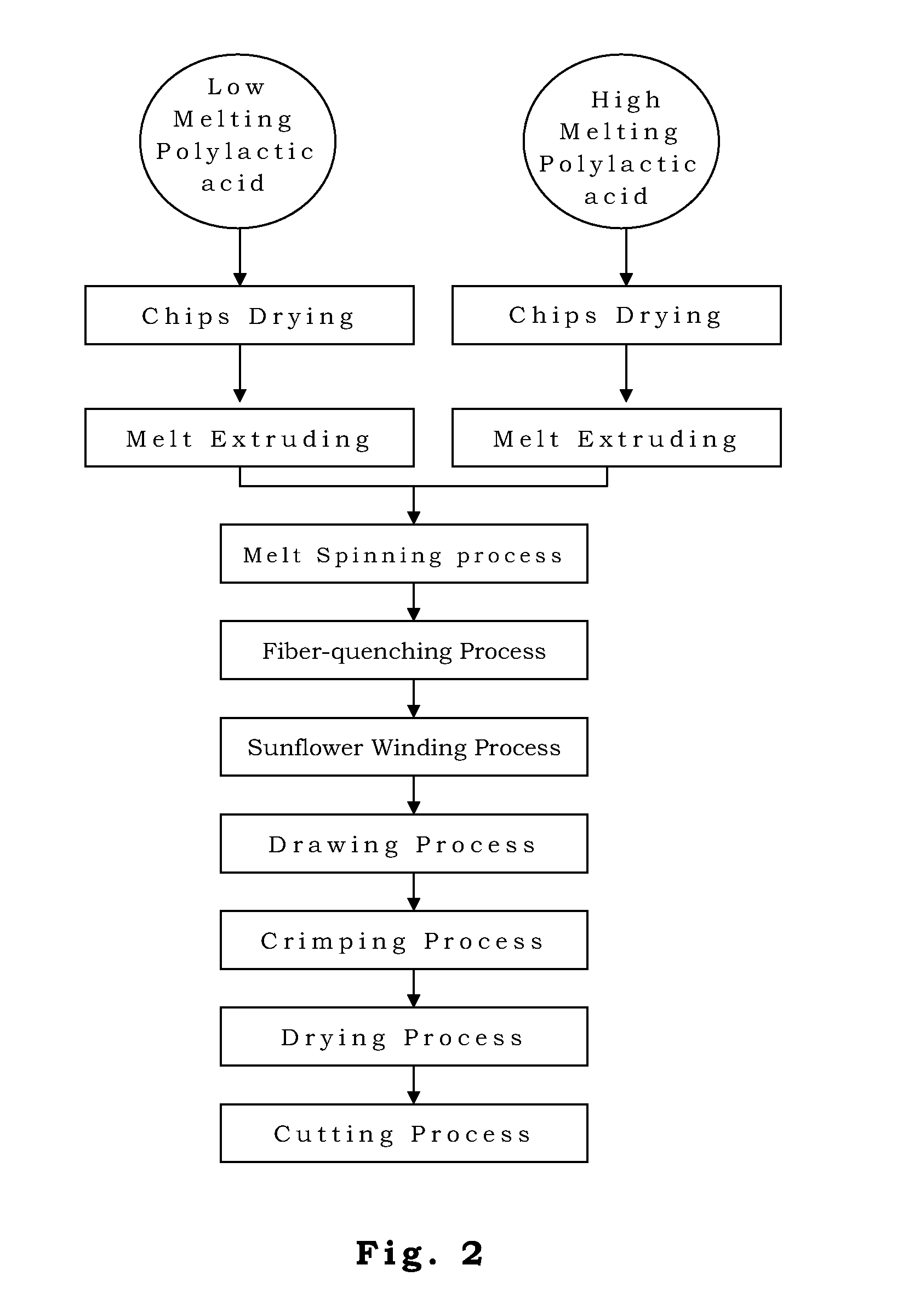Heat Adhesive Biodegradable Bicomponent Fibers
a biodegradable, fiber technology, applied in the field of heat adhesive bicomponent fibers, can solve the problems of low melting component material comprising unmodified polylactic acid, and achieve the effects of excellent thermal bonding, high melting component, and low melting
- Summary
- Abstract
- Description
- Claims
- Application Information
AI Technical Summary
Benefits of technology
Problems solved by technology
Method used
Image
Examples
example 1
Manufacturing 2 Denier Sheath / Core Bicomponent Fiber
[0029]Referring to FIG. 2, a method for manufacturing a sheath / core bicomponent fiber, shown in the following.
[0030]Low melting polylactic acid raw material 6300D from Nature Works (the content of D-lactic acid is 8.5 wt % and Tm=132° C.) is used as the sheath of the bicomponent fiber. On the other hand, high melting polylactic acid raw material 6201D from Nature Works (the content of D-lactic acid is 1.4 wt % and Tm=168° C.) is used as the core of the bicomponent fiber.
[0031]Independent dryer systems are used to dry the two polylactic acid raw materials to below 50 ppm of moisture content. The sheath (6300D) and the core (6201D) are melted by each extruder. The extruder for the sheath is divided into six heating zones and the temperatures are set to 190, 200, 200, 210, 210, and 210° C. Comparatively, the extruder for the core also can be divided into six heating zones and the temperatures are set to be 220, 230, 235, 237, 237, and...
example 2
Manufacturing 2 Denier Modified Sheath / Core Bicomponent Fiber
[0037]Keep the low melting polylactic acid chips (nature works 6300D) and maleic anhydride chips at the ratio 96.5 w.t % and 3.5 w.t %, after mixing and drying procedure then feed into a twin-screw extruder. The chips are melted and completely blended by twin-screw extruder system to get the modified polylactic acid polymer. The melted modified polylactic acid is extruded from the extrusion die and thus cooled, granulated to get the modified polylactic acid chips.
[0038]Modified polylactic acid and low melting polylactic acid are mixing well with the ratio 15 w.t % and 85 w.t % are used as the sheath portion of the bicomponent fiber. On the other hand, high melting polylactic acid raw material 6201D from Nature Works (the content of D-lactic acid is 1.4 wt % and Tm=168° C.) is used as the core of the bicomponent fiber. The bicomponent fiber is made by below melt spinning process.
[0039]The independent dryer systems are used ...
example 3
[0048]The object of this test is to evaluate the bonding performance between polylactic-acid-based bicomponent fibers and mono-component fibers by different weight ratio of the sheath and the core portion of the bi-component fibers and also to compare with the hand feeling of nonwoven.
[0049]In this test, 50 g of sample fibers with 75% by weight of polylactic-acid-base monocomponent fibers (had a fineness of 6 denier and a length of 64 mm) and 25% by weight of polylactic-acid-base bicomponent fiber is used. The sample fibers carded by carding machine twice and made the web with basis weight 250 g / m2. The web is placed in an oven for thermal bonding process at 140° C.×5 min. After bonding process, the nonwoven is taken out from the oven and cut into individual samples with a size of 5 cm×30 cm for tensile tests by a tensile test machine (INSTRON-4301) to measure the nonwoven strength and elongation. The data are shown in Tables 1 and 2.
TABLE 1Sheath / coreratioItemTypeSheathCore(wt %)1p...
PUM
| Property | Measurement | Unit |
|---|---|---|
| Fraction | aaaaa | aaaaa |
| Percent by mass | aaaaa | aaaaa |
| Length | aaaaa | aaaaa |
Abstract
Description
Claims
Application Information
 Login to View More
Login to View More - R&D
- Intellectual Property
- Life Sciences
- Materials
- Tech Scout
- Unparalleled Data Quality
- Higher Quality Content
- 60% Fewer Hallucinations
Browse by: Latest US Patents, China's latest patents, Technical Efficacy Thesaurus, Application Domain, Technology Topic, Popular Technical Reports.
© 2025 PatSnap. All rights reserved.Legal|Privacy policy|Modern Slavery Act Transparency Statement|Sitemap|About US| Contact US: help@patsnap.com



